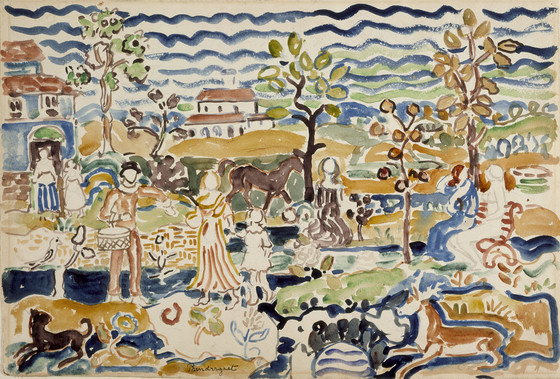Decorative Composition is characteristic of Prendergast’s theme of promenades but atypical stylistically. It was painted during an experimental period in the artist’s career....
Decorative Composition is characteristic of Prendergast’s theme of promenades but atypical stylistically. It was painted during an experimental period in the artist’s career. While earlier watercolors reveal Prendergast’s increasing use of individualized brush strokes as abstract, notational elements, he usually painted with short strokes rather than long lines. In this composition the wavy lines in the sky are especially unusual, as is the formation of white lines by leaving the paper exposed. The effect is fauvist, like the art of Henri Matisse (1869-1954), and recalls the arabesque linearity of the decorative, incised and painted panels his brother Charles began creating around the same time.
Art historian Eleanor Green suggests that the unusual style and period costumes worn by the figures may have been stimulated by the Prendergast brothers’ set designs for the King-Coit Children’s Theater group in New York. Unfortunately the designs for these sets are lost. Soon after completing this watercolor, Prendergast created two mural-size canvases that also reveal experimental brushwork with shorter, more mosaiclike strokes and a similar exploitation of the white of unpainted areas (Picnic, 1914-15, Carnegie Museum of Art, Pittsburgh; Promenade, 1914-15, Detroit Institute of Art).
Decorative Composition was admired and bought by two of the most important early twentieth-century collectors of American art. John Quinn, who owned one of the finest private collections of Prendergast works, bought Decorative Composition in 1915 out of the Carroll Galleries exhibition. The painting remained in his possession until his death in 1924, after which it was acquired by William Preston Harrison. The oil painting Decorative Composition now in the Hirshhorn Museum and Sculpture Garden (Smithsonian Institution, Washington, D.C.) was once believed to have been the one owned by Quinn. However, dealer Antoinette Kraushaar recently recalled that her father, C. W. Kraushaar, sold the Quinn painting to Harrison and not to Hirshhorn.
On the verso is an unfinished sketch, not unlike studies of the sea that Prendergast did in Saint Malo, France, around 1909.
More...
